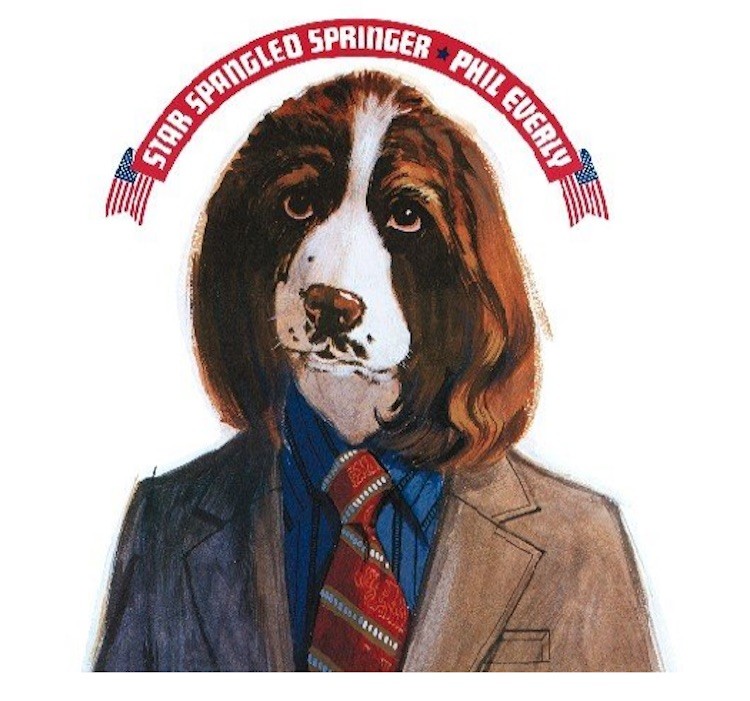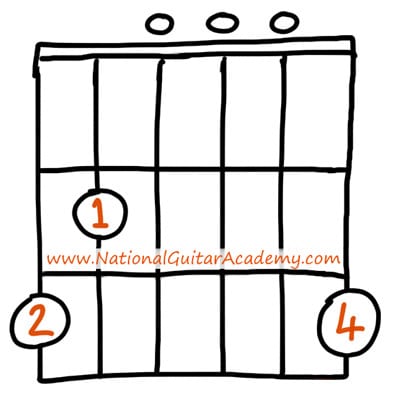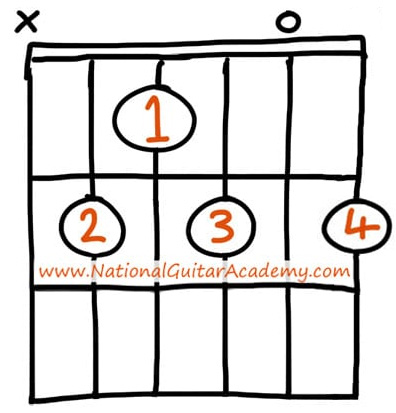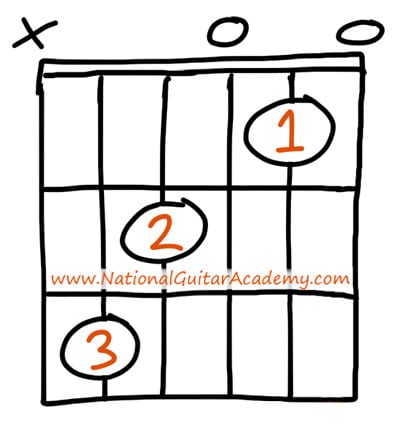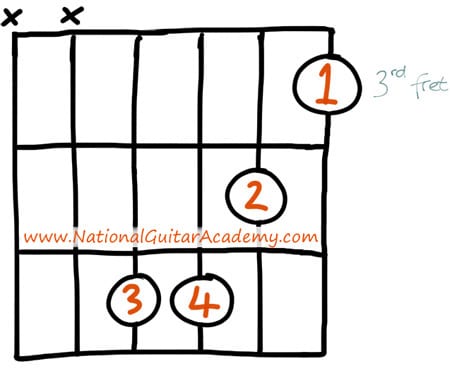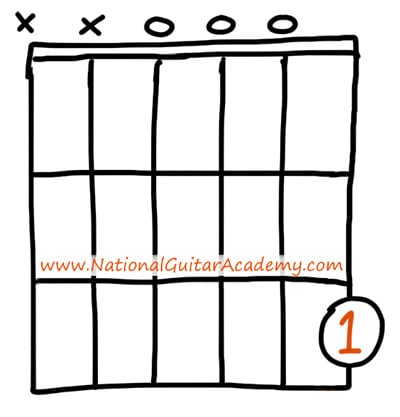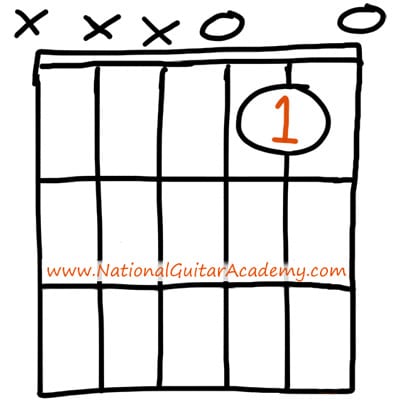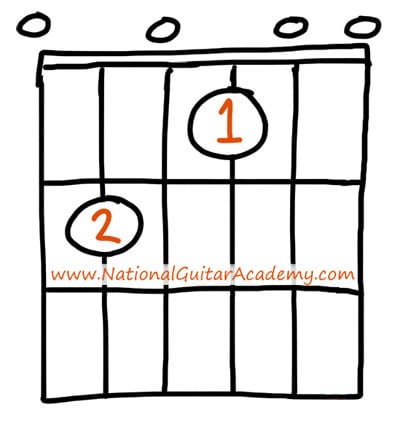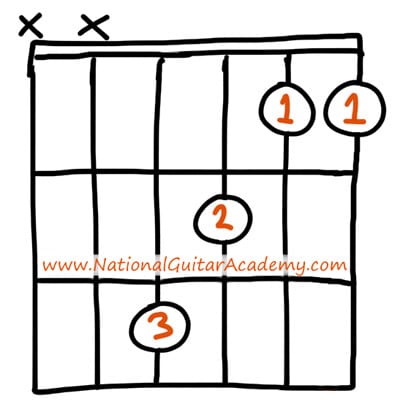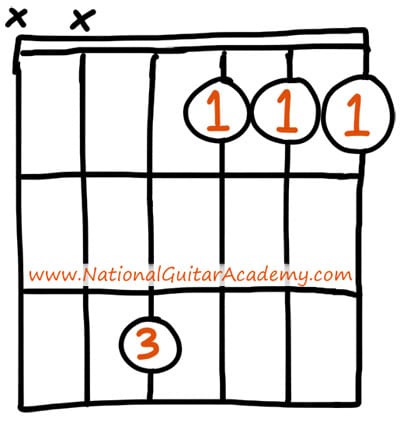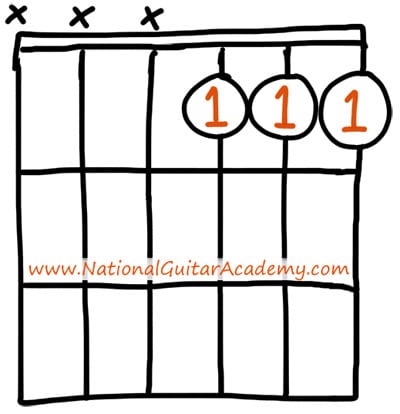Are you ready to learn how to play Radiohead’s Creep chords? Let’s dive in!
Over 100,000 guitar-learners get our world-class guitar tips & tutorials sent straight to their inbox:
Click here to join them
Get our best guitar tips & videos
In this free lesson you will learn…
- How to play Creep by Radiohead
- How to transpose to a different key
- How to analyze song structure to make learning easier
- How to play this song in multiple keys
Everybody Can Learn To Play Some Radiohead!
There just aren’t a whole lot of bands that bridged the gap between the 1990s and the 2010s, the way that Radiohead did.
- Their continued presence on the airwaves and our playlists owes a lot to their commitment to giving us something fresh and amazing every single time.
- What put them over the top and into our concert halls and playlists in the first place though, was just one song: Creep.
- Creep is compelling, powerful, and one of the biggest hits in Radiohead’s three-decade run. It’s also a simple four-chord progression, easy to play on the guitar and sing.
So let’s just go ahead and add these Creep chords to your growing repertoire today! Keep reading!

In this lesson, we’re going to show you the Creep chords in different keys.
- This means you’ll be able to play this song to match your level of experience on the guitar, whether you’ve been playing for two weeks or twenty years.
- You’ll also be able to match the Creep chords to your vocal range or conform them to the key of the recording, whichever suits your preference.
- Note to young readers: Creep contains lyrics which, if you were to utter them in the presence of your school teachers, would result in a call home to your parents.
Spare your parents the phone call, please.

Creep Chords: The Songwriting Rabbit Hole
Creep is a song that is right smack in the middle of the 1990s’ alternative rock wheelhouse, but it wasn’t noticed right away.
It was initially released as Radiohead’s debut single. It didn’t really go anywhere then, nor when Pablo Honey, their first album, was released.
Creep finally caught some traction when it was re-released, and that’s when everyone immediately noticed what the band knew all along:
- The chord progression and some of the melody was directly lifted from a song titled “Air That I Breathe”.
- The first note of “Air That I Breathe,” according to Eric Clapton, had more soul than anything he’d ever heard.
“Air That I Breathe” was a late-career hit for the Hollies in 1974, the height of the Western world’s love affair with a genre alternatively called easy listening.

Oh, but the Creep chords and melody have an even deeper history than that. The Hollies did not compose “Air That I Breathe,” although their cover version was the height of the song’s fame.
That may be because it was produced by Alan Parsons, who had recently come off of his last job, engineering the Pink Floyd album Dark Side of the Moon.
“Air That I Breathe” was composed by Mike Hazlewood and Albert Hammond. Hammond had one major hit in the 1970s, the title track from the album that also contains “Air That I Breathe:” It Never Rains in Southern California.
The song didn’t do much for Hammond, but Olivia Newton-John did it on her 1975 album, Have You Never Been Mellow.
Phil Everly covered it on his 1973 album Star Spangled Springer. Everly’s version is important because that’s the one the Hollies heard and used as their template.
Learn 12 EASY beginner chords with our popular guide


Where should we send it?
✅ Stop struggling. Start making music.
✅ Learn beginner-friendly versions of every chord.
This is our most popular guide and it will improve your chord ability quickly! 😎
Get your own personalised guitar-learning plan 🎸
Get a custom guitar-learning plan here: Click here for GuitarMetrics™
World-Class Guitar Courses 🌎
Learn from the world's best guitar educators: Click here for our guitar courses
Creep Chords: Radiohead’s Take
Everything above is why when you look at the album credits for Creep, you’ll see Hazlewood and Hammond’s names as songwriters.
- They weren’t immediately credited, although Thom Yorke was surely aware of the source of the Creep chords and some of the melody.
- As those of you who dabble in songwriting know, your ideas often come from somewhere.
- When you’re just a bunch of guys trying to get something going, it’s perfectly normal to borrow elements from songs you love.
Hazlewood and Hammond were named as songwriters after the “Air That I Breathe” publisher instituted copyright infringement proceedings against Radiohead. The suit settled and all is well.
Creep is recognized now as an immensely popular homage to a formerly immensely popular song, as well as a worldwide hit in its own right.

When Yorke first brought Creep into the studio for Radiohead to record, he referred to it as the band’s “Scott Walker song.”
- The rest of the band initially thought that meant they were recording a cover.
- It was Jonny Greenwood who, hating the song’s quiet meandering mellowness, turned his guitar up as loud as possible and gave us those aggressive guitar stabs.
- Creep was transformed from a Mellow Gold-derivative track into Radiohead’s first major hit, and one of their most enduring songs.
Let’s have a listen, shall we?
Now that you know the best parts of this song’s fascinating and deep history, let’s get you playing the Creep chords!

Pro-Tip: You never know when your historical knowledge of a song will come in handy.
Use it to inform your own arrangement. Better yet, bits of song history come in very handy when you suddenly find yourself having to tune your guitar onstage and need some banter!
To top that off, it’s helpful to take hints from different musicians who have covered the song in order to inform your own musical approach to the song.
Check out Postmodern Jukebox & Haley Reinhart’s version of Creep here.
Creep Chords: The Progression
As recorded by Radiohead, Creep is in the key of G major. The chords you’ll need for the entire song in this key, if you’re a relative beginner on the guitar, are listed below:
G (320003)
(If you don't understand the above image please read our article "How To Read Guitar Chordboxes In 60 Seconds". It will make everything clear!)
B7 (x21202)
C (x32010)
Cm (xx5543)
If you’re just starting out on the guitar, there are some simpler versions of the Creep chords in the key of G major, so try these shapes out while you’re ramping up:
G (xx0003)
B7 (xxx202)
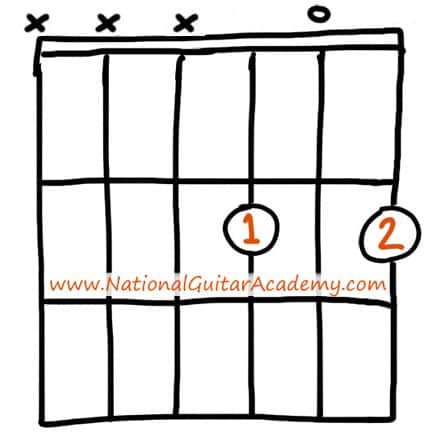
C (xxx010)
Cm (xxx043)
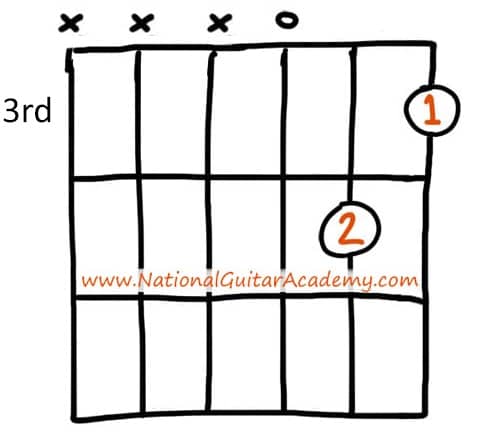
For those stepping-stone chord shapes, make sure you’re only hitting the G, B, and E strings. Practicing this way will quickly sharpen your strumming skills!
The Creep chords can also be played as a barre-chord workout, using E chord shapes. If you’re interested in playing this song as it is on the recording, try these out:
G (355433)
B (799877)
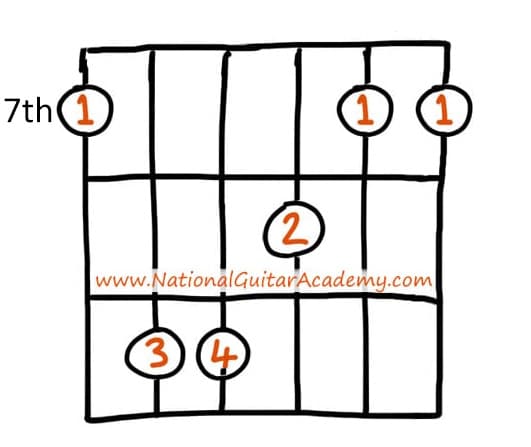
C (8 10 10 9 8 8)
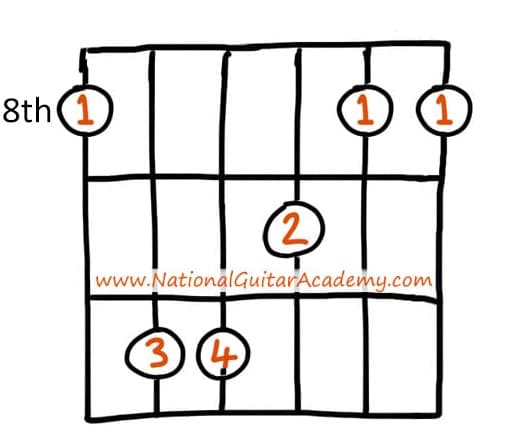
Cm (8 10 10 8 8 8)
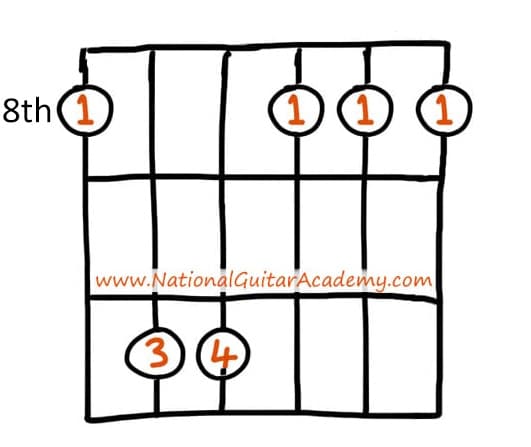
Pro Tip: There is always more than one way to play a chord, and the guitar is full of different possibilities that can make your life easier.
If you aren’t comfortable playing some of these six-string chord shapes yet, simply try splitting them in half and only playing either the top or bottom three strings!
Don’t overwork your hands just yet!
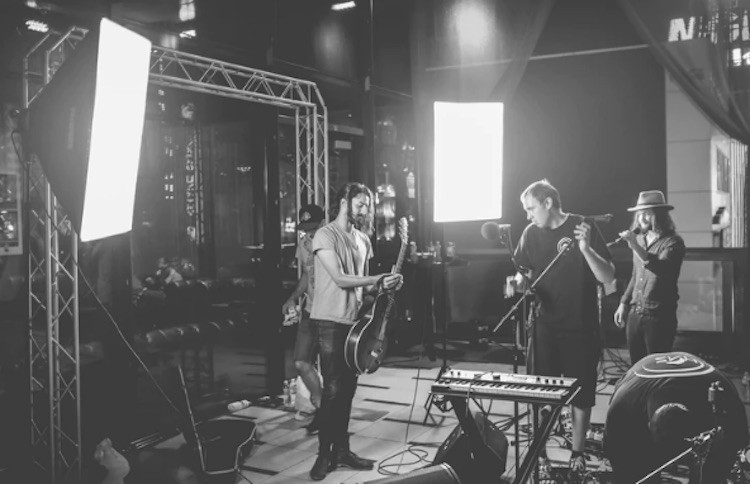
Creep Chords: The Intro
The entire song cycles through those four chords above, two measures each.
- Before the singing starts, there’s a pretty little guitar introduction. It also cycles through those four chords.
- Of course, you can simply strum through those chords before beginning to sing, in whatever way strikes your fancy.
- In the recording, the chords are arpeggiated, played one note at a time.
Arpeggiated chords work well for quiet and slow songs because they keep the song moving at a slow tempo without becoming too busy or noisy and ruining your song arc.
The only requirement of an arpeggio is that you hit the root of the chord on the first beat of the measure.
For the Creep chords that use open positions in the key of G, you can play an intro that looks like this:
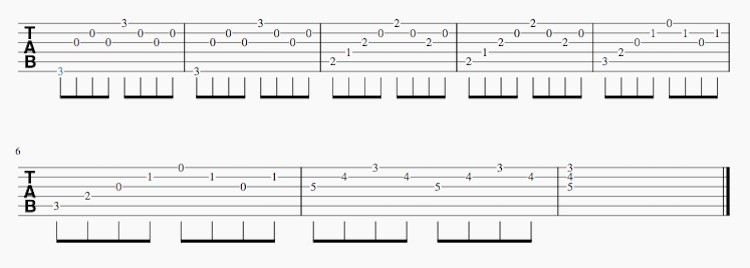

The intro on the recorded version is played with barre chords, using the shapes we’ve discussed above.
- Arpeggiating barre chords is a wonderful and instructive way to become very honest with yourself about the tone of your barre chords.
- We all know how challenging it can be in the first place to get them sounding like anything at all!
- Listening to them one note at a time shows you exactly where you can adjust your hand position or grip on the neck to improve your sound.
If you’re ready to tackle the full barre-chord-based intro to Creep as played by Radiohead, here is a chart of tablature you can use.
The arpeggiated intro extends through the first verse, and you can keep it going while you sing.

Creep Chords: The Rhythm
At the end of the first verse of Creep, the song really kicks in with the aforementioned Jonny Greenwood guitar stabs, and the whole personality of the song changes.
You don’t need a burst of electric guitar to change the personality of the song, as surprising and energetic as it is when Greenwood does it.
- It’s good to think about what you want to have happen in your arrangement.
- Changing the rhythm is an effective way to change a song’s message and direction.
- In the recording, the main rhythm is a straight eighth-note strum, taking the song from lacy arpeggios to jangly alt-rock drive.
Usually, we perform straight eighth notes as a constant down-up strum, but you can make that sound fuller and more powerful by using all down strums.
Bands like Oasis and The Stone Roses can show you the marvelous effect of the simple eighth-note strum.

Creep Chords: The Song Structure
Now that you’ve got the Creep chords and rhythm together, all you need is to shape the song in a way that feels good to you and matches the recording!
There’s no rule that says you have to follow the structure of the recording, but this song is instructive in the use of dynamics – how loudly or quietly you’ll be playing at any given moment.
- Radiohead is quiet until right before the first verse, then very loud, and then quiet through the second verse.
- The second chorus and middle eight are loud, maybe the apex of the song, and then it begins its descent for the final verse and chorus.
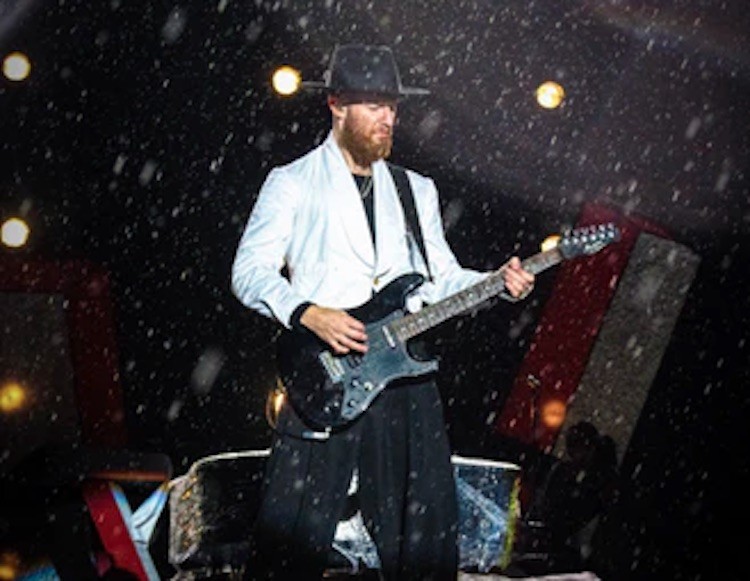
Creep is a pretty simple song to memorize; there are only two verses and a chorus to remember. Everybody already knows the middle part as well as the chorus – “I’m a creep” & “She’s running out the door…”.
The structure of the recording is pretty standard. Since you know the chords, it’s not going to be too difficult to get through the entire song, in this order:
Intro (x1)
Verse (“When you were here before”) (x2)
Chorus (“I’m a creep) (x1)
Verse (“I don’t care if it hurts”) (x2)
Chorus (x1)
Middle Section (“She’s running out the door”) (x2)
Verse (“Whatever makes you happy”) (x1)
Chorus (x1) Quietly
If you’d like a complete chart of the Creep chords and lyrics, we’ve found one for you right here! Enjoy!

Download our lead guitar cheat-sheet to make things easier
It's hard to understand which scales work with which keys.
So we created a cheat-sheet! A key and scale-finder that you can use again and again.
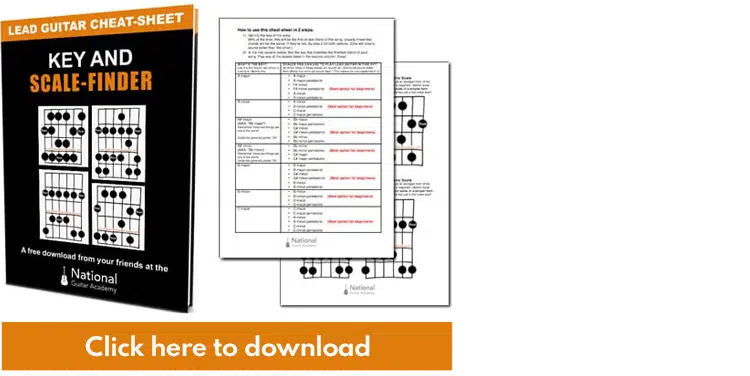
Get your personalised guitar-learning plan 🎸
Get a custom guitar-learning plan here: Click here for GuitarMetrics™
World-Class Guitar Courses 🌎
Learn from the world's best guitar educators: Click here for our guitar courses
Creep Chords: Key Of C Major
The same chord progression can sound quite different when played in a different key.
Changing the key of a song retains the relationship between the chords while shifting the starting point.
- The result is the same song, but a bit higher or lower depending. You can change the key to suit your ear, your favorite chords, or your vocal range.
- One way to do this is with a capo. You can use the Creep chords in one of the key of G major formulations above and put your capo on to adjust the key.
Another way to change the key, and to learn a bit about chord relationships at the same time, is to transpose using music math. Keep reading!

Transposing a song involves using the chromatic scale like a decoder ring. To transpose the Creep chords from G to C, we first have to figure out how far apart those two notes are.
- Counting up the chromatic scale, we get G, G#, A, A#, B, C. That’s five half-steps.
- We’ll count every chord up five half-steps to keep the relationships the same.
- The G chord becomes the C chord. You already know how to play a C chord! So far, so good.
Count the second chord, B or B7 (they’re interchangeable!) up five half-steps. B, C, C#, D, D#, E. The B or B7 becomes an E or E7.
E (022100)
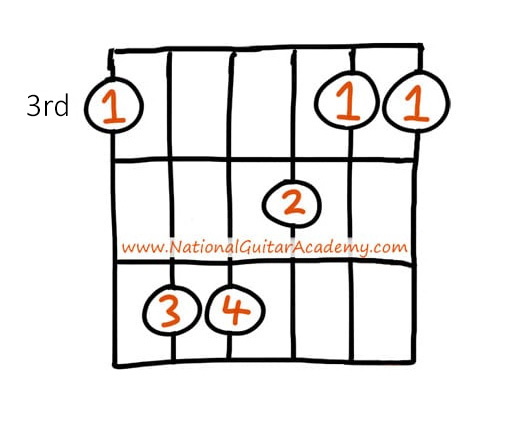
Taking the third chord, C, up five half-steps gets us an F chord. You can play it either of these ways:
F (xx3211)
Fmaj7 (xx3210)
The last chord, Cm, becomes Fm. Try one of these:
Fm (xx3111)
Fm (xxx111)

Working the Creep Chords Into Your Song Repertoire
There are so many 1990s songs you can play along with this one to make a great set for a singalong or an open mic!
We absolutely love practicing with the Hal Leonard Play-Along series, which includes this 1990s Alternative Rock book and audio.
Recommended Resources
If you’ve enjoyed this lesson, we have other places for you to go next! Continue on your path with these lessons:
What Type of Guitarist Are You?
Take our 60-second quiz & get your results: Take The Quiz
Join the world's best online guitar school 🌎
- Get your own personalised guitar learning plan (customised just for YOU).
- World-class online guitar courses. Learn at your own pace.
- Community Campus & Learning Forum - A friendly community! Connect with our team & students. 😊
- Beginner Song library with chordsheets, tabs and tips. (Songs suitable for all levels!)
- Regular live streams, seminars and Q&A sessions - Learn from world-class guitar educators. Get all your questions answered!
Click here to learn more about National Guitar Academy membership 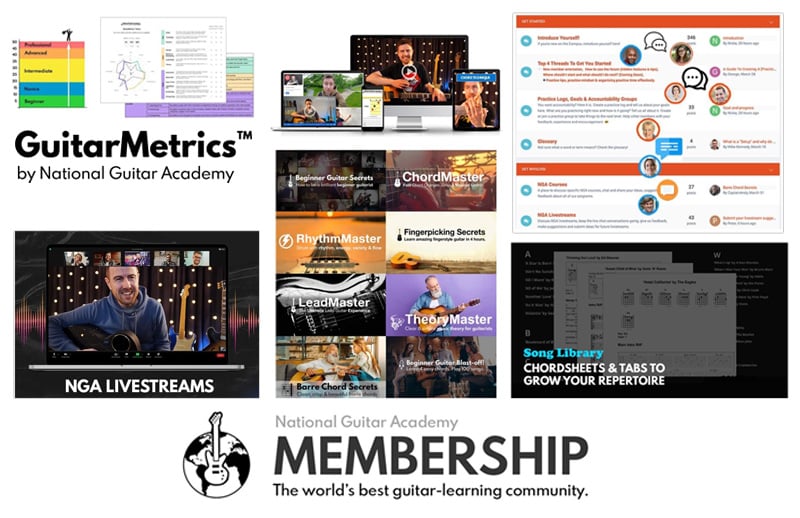
Cool Guitar T-shirts 😎
Look cooler! Check out our merch: Click here to see our merch store
Want free guitar tips and video lessons delivered to your inbox?
Join over 100,000 guitar-learners and subscribe to our guitar-tips-by-email service. (It's free.)
We'll send you a series of lessons that will move you to the next level of your guitar journey.
Learn how everything fits together quickly, easily and effectively. We share ninja tips (for instant fun!) but also timeless fundamentals that will deepen your understanding.


Get our best guitar tips & videos
Popular Lessons
How To Learn Guitar: An 11-Step Programme For Beginners
How To Choose The Perfect Beginner Guitar
More Cool Guitar Stuff
Learn about National Guitar Academy: About Us
Join us on Facebook for daily guitar tips.
Listen to our Learn Guitar Podcast for rapid guitar progress.
Check out our free chord lessons.


